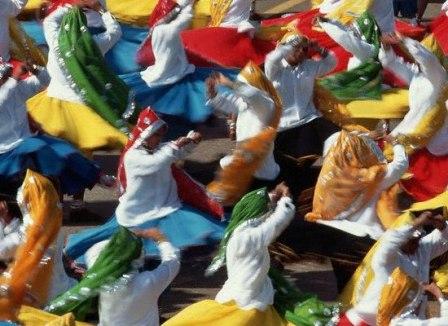
The cultural diversity and religious unity are the core values of the Indian society. Delhi, being the capital of India, naturally reflects it all, as people from different states come here for best education, best medicinal assistance and good job opportunities. It is a centre stage of Indian politics too and represents all that is best in the country. The metropolitan city with a cosmopolitan outlook, New Delhi boasts of a rich cultural heritage. The ancient city still reflects the remnants of the glorious old-age charm and culture, yet has a very modern and chic lifestyle. The nightlife is interesting and a number of discos beckon the youngsters to sway and dance on enchanting numbers.

At the Nizamuddin Shrine, one can still hear the 'Qawwalis'. 'Gurbani' (the verses from the Granth Sahib) and prabhat ferries can be heard in the Gurudwaras, 'bhajans' and 'aartis' in the temples and Sunday masses in Churches. The traditional fairs and festivals like 'Phoolwalo-Ki-Sair' are still being celebrated. With the increasing number of people from different states, the regional festivals like 'Chhath Puja' of Bihar and 'Durga Puja' of Bengal are also being observed. Since Delhi shares its borders with Haryana, Rajasthan, Uttar Pradesh and Punjab, its people and their lifestyle is often influenced greatly by these regions.

Though Punjabis dominate Delhi, it has now developed a number of pockets dominated by other communities also, such as South Indians in R.K. Puram and Bengalis in C.R. Park. It is this diversity that makes Delhi so lively and colorful. Indo-Persian art is reflected in Jama Masjid, while Birla Temple and the Chattarpur Temple complex exude amalgamations of North and South Indian architectural styles. Lotus temple is notable not only for representing the Bahai way of worship, but also the splendid architectural design. Jains and Buddhists also have their own shrines in the city, while the Tibetan monastery near the Interstate bus terminus is representative of the Tibetan culture in India.




At the Nizamuddin Shrine, one can still hear the 'Qawwalis'. 'Gurbani' (the verses from the Granth Sahib) and prabhat ferries can be heard in the Gurudwaras, 'bhajans' and 'aartis' in the temples and Sunday masses in Churches. The traditional fairs and festivals like 'Phoolwalo-Ki-Sair' are still being celebrated. With the increasing number of people from different states, the regional festivals like 'Chhath Puja' of Bihar and 'Durga Puja' of Bengal are also being observed. Since Delhi shares its borders with Haryana, Rajasthan, Uttar Pradesh and Punjab, its people and their lifestyle is often influenced greatly by these regions.
Though Punjabis dominate Delhi, it has now developed a number of pockets dominated by other communities also, such as South Indians in R.K. Puram and Bengalis in C.R. Park. It is this diversity that makes Delhi so lively and colorful. Indo-Persian art is reflected in Jama Masjid, while Birla Temple and the Chattarpur Temple complex exude amalgamations of North and South Indian architectural styles. Lotus temple is notable not only for representing the Bahai way of worship, but also the splendid architectural design. Jains and Buddhists also have their own shrines in the city, while the Tibetan monastery near the Interstate bus terminus is representative of the Tibetan culture in India.



